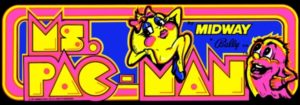This VGC Essay was first published on March 10, 2017
 It’s easy to forget nowadays, but Ms. Pac-Man was actually created by accident. Like Doc Brown’s invention of time travel after a tumble from the toilet, Ms. Pac-Man was created when a group of game developers from MIT attempted to release an unauthorized sequel to Pac-Man known as “Crazy Otto.”
It’s easy to forget nowadays, but Ms. Pac-Man was actually created by accident. Like Doc Brown’s invention of time travel after a tumble from the toilet, Ms. Pac-Man was created when a group of game developers from MIT attempted to release an unauthorized sequel to Pac-Man known as “Crazy Otto.”
Before turning their sights on the biggest arcade game of the day, the development team, General Computer, first used their programming skills to create an “enhancement kit” for Atari’s Missile Command. Instead of creating their own game from scratch, the enhancement kit hooked into Atari’s code and altered it to provide a new gameplay experience. Essentially, General Computer created the first expansion pack.
Even though the enhancement kit required an original Missile Command cabinet, Atari later attempted to sue General Computer for copyright infringement. But rather than become mired in a protracted court case, the arcade giant and the enterprising college students reached a settlement. Atari would hire General Computer to design original arcade games so long as they agreed not to create any additional enhancement kits without the permission of the original game publisher. The developers quickly signed on, but first they took a nearly complete version of “Crazy Otto” to Midway, the North American distributor of Pac-Man.
![]() VGC Essays are original articles discussing each title from the Video Game Canon, as well as their place in gaming history, how the community embraced them in the past, and how they might help shape games in the present day.
VGC Essays are original articles discussing each title from the Video Game Canon, as well as their place in gaming history, how the community embraced them in the past, and how they might help shape games in the present day.
By the midpoint of 1981, Midway was getting nervous. Pac-Man had been available for over a year and Namco, the Japanese company that created Pac-Man, hadn’t even begun work on a sequel. Players still loved the game (more than ten billion quarters would be dropped into Pac-Man cabinets over the next 30 years), but something new was being shipped to arcades all the time. Rather than be left behind, Midway signed a deal with General Computer to publish “Crazy Otto” as “Pac-Woman.”
After much discussion within General Computer, “Pac-Woman” would eventually morph into “Miss Pac-Man” and then “Mrs. Pac-Man,” until the team finally settled on Ms. Pac-Man. With its quartet of mazes, randomized ghost paths, and other improvements, the game would go on to become even more popular than Pac-Man. And even though Midway was instrumental in bringing Ms. Pac-Man to the public’s attention, they would eventually turn over all rights to the game to Namco as they didn’t actually have the legal authority to commission a sequel to Pac-Man in their role as the game’s North American distributor.
Towards the end of 1982, Namco would eventually release Super Pac-Man, the first official sequel to Pac-Man. It is almost completely forgotten today, most likely due to switching out the game’s signature dots for keys that remove walls from the maze. In this age of annualized (and sometimes twice-yearly) sequels, it’s almost unthinkable that it took the company more than a year to even begin development on a sequel to Pac-Man.
Toru Iwatani, the project leader on Pac-Man, was busy working on Pole Position at the time, and would have little connection to the dozens of sequels and spinoffs that Namco would eventually release. However, before embarking on a second career as a college lecturer, the game developer returned to Namco in 2007 to create a Pac-Man sequel of his own design… the heavily stylized (and very well-received) Pac-Man Championship Edition.
How To Play It Today
Like its predecessor, Ms. Pac-Man was extremely popular with players in the 1980s, and the cabinet can still be found in many arcades to this day.
If you’d prefer to play Ms. Pac-Man on your couch, there are a huge number of options across dozens of different platforms. The game was most recently re-released as a standalone download for the PC, PS4, and Xbox One, but it can also be purchased through digital storefronts on the PS3 and Xbox 360 as well.
Game Information
Publisher: Midway, Namco
Developer: General Computer
Release Date: July 1981
References and Further Reading
Goldberg, Marty and Curt Vendel – Atari Inc.: Business Is Fun – Syzygy Press – 2012
Kent, Steven – The Ultimate History of Video Games – Three Rivers Press – 2001
Rignall, Jaz – USgamer – Top 10 Highest-Grossing Arcade Games of All Time – 2016
Next Essay: Tetris
